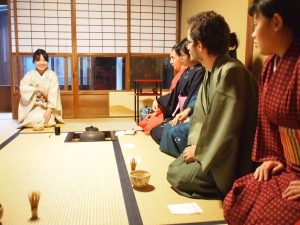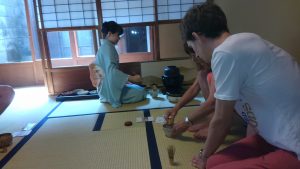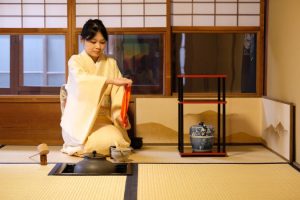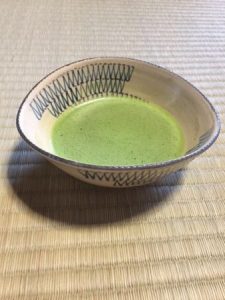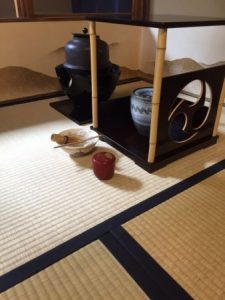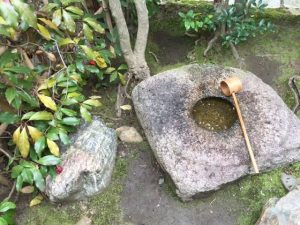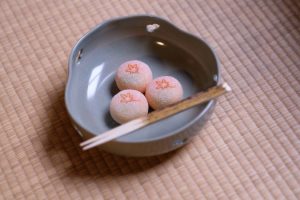An authentic tea ceremony experience for foreign tourists~~Tea Ceremony Koto
Nearly everyone who visits Kyoto for the first time visits Kinkakuji Temple, the golden pavilion, one of the Japan’s world heritage sites. Tourists from all over the world walk to Kinkakuji every day. Tea Ceremony Koto is just a two-minute walk from the temple. They are renowned as a place where tourists can have an authentic Japanese tea house experience in English.
As we enter the room, the smiling face of Rie Kuranaka (30), a tea master of the Urasenke school of tea ceremony, welcomes us like friends into her home. For now, the atmosphere is friendly and relaxed, the strict formalities and manners of the ceremony have been dispensed with. In spite of that, once we enter the room there is a comfortable tension under the tranquil atmosphere.
A family (father, mother, daughter & son) from Switzerland are also visiting Tea Ceremony Koto today. I overhear that the son is now studying at a University in Osaka prefecture as an exchange student. Although he has some knowledge about Japanese culture, it is his first time participating in a tea ceremony. He whispers explanations of things like “tokonoma are…” for his parents, as they look intimidated by their first experience with traditional Japanese culture. Their first hurdle is sitting on the tatami floor in the seiza style (a traditional Japanese style of sitting on your knees while resting your bottom on top of your ankles.) They look to be enjoying the experience, though continuing to sit up straight in the position seems impossible. Finally, Rie kindly allows the beginners to sit any way they would like.
The tea ceremony is held and explained in fluent English. The tea master, Rie Kuranaka, lectures in a friendly way and her explanations are great. The lecture is not only about manners, but also the meaning of, history (from the late eighth century to today), and spirit of tea ceremony, “wa kei sei jaku”. She goes on to explain the hanging scrolls in the room and the utensils used in the ceremony, all of which have their own meanings. This introduction is great for Japanese beginners as well. Although tea ceremony is a deep, complicated art, she is able to explain things clearly and in an easy to understand way. At some point the Swiss family forgot the difficulties of their seiza and began leaning forward to listen more carefully.
Rie explains the meaning of each set movement within the ceremony and why she has chosen the specific utensils she has for today, all in a way that is clear and friendly for her foreign guests. Now that the introduction is over, the time for the ceremony, “the way of tea” has come.
The father looks as though he’s worried about remembering the greetings for the ceremony and asks his daughter to confirm. He then smiles and says “My feet have fallen asleep!” The son explains things in French for his mother. She nods her head over and over but her son still seems worried for her.
The tea ceremony begins! A tranquil atmosphere fills the room. Everyone watches the host’s movements carefully. The family seems especially impressed as Rie purifies the utensils with a ceremonial red cloth. The father exclaims “It’s like magic, beautiful!” Rie explains the meaning of each movement as she makes a bowl of tea for each guest. The family whispers questions and answers to each other throughout. Finally, as they were taught before, the guests speak the greetings and ritual phrases in English and drink. A look of relief passes over their faces and the mother smiles and says “It’s delicious!”
Next the guests are able to experience making and whisking the green tea by themselves. Rie walks each guest through the process step by step in English. Everyone looks intent on learning. The son says “It didn’t look difficult at all when we watched, but using the bamboo tea whisk is hard! I can’t get the tea to froth.” Contrary to expectations, the father does well and smiles as he is praised by the instructor. He looks at his daughter as if wanting to say “This is how you do it!”
“How was your tea?” Rie asks the family. “Making it was fun, but your tea was far better.” the son replies. “Of course it was!” the mother adds.
Now, after the ceremony, the guests have time to ask questions.
Things like “Are all the movements precisely decided?” “Are there schools of tea ceremony?” “Do you do this at home with your family as well?” “What else do you do in a formal tea ceremony?” Rie takes the time to answer each and every one.
The class lasted 45 minutes, but it was a 45 minutes full of new cultural experiences.
-Interview with Rie-
“I try to explain clearly without using difficult words since most of my guests are tourists and beginners.” Rie says.
“This tea house is for beginners and tourists, but I don’t want to explain too casually or superficially. Of course, it’s impossible to explain everything in just 45 minutes, but I’d like my guests to experience this authentic Japanese culture as precisely as possible.”
Rie says “feeling the season and the moment in a tea room” are particularly important for a traditional tea ceremony. “For example, how do you feel when you see this flat container made of pottery? You might think ‘It’s just a water container, isn’t it?’ But it has its own meaning. To create a cooler atmosphere in summer, we choose a flatter container to show as much of the surface of the water as possible.” If she were to merely perform the ceremony in silence her guests from overseas would probably not come to understand its meaning. Through her lecture foreigners have the opportunity to learn much more about the ceremony. Many tourists say they don’t have any customs for choosing different tea cups for each season or serving with different cups for different guests.
Rie devises new ways of explaining the ceremony every time, depending on how familiar the guests are with tea ceremony and Japanese culture. “Since I meet new guests from all over the world every day, it’s challenging and exciting for me”, she said.
In Japan, hearing the title “tea master” we tend to think he or she is born into a tea family and started learning the ceremony from the age of 5 or 6, but Rie is different. She started learning tea ceremony after her graduation from university. She first worked in a bank and as the rigors and hardships of the job got to her, tea ceremony helped. “I never thought I would love tea ceremony so much. I was not interested in doing something so formal or prescribed before, but it really helped me to feel calm.” Because of her unique background in the world of tea ceremony I think Rie can put herself in the shoes of a beginner and help them to know how fun it can be.
I highly recommend Tea Ceremony Koto any time you’re entertaining guests from overseas. It’s a wonderful place to learn about the world of tea ceremony for beginners!
*This translated article is originally written by Toshimi Aishima, the founder of Kansai women’s college in Japanese.






